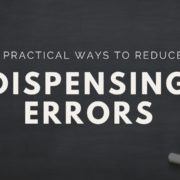LEARN THROUGH VIDEO
LEARN THROUGH READING
Reflection
What are we going to learn?
In this module, we’re going to learn about 5 practical methods of reducing the rate of dispensing errors in the pharmacy.
How and why is this learning relevant?
This is always a hot topic in the pharmacy world and has recently come to light with a couple of significant dispensing errors we’ve seen on the news. We as pharmacists are under mounting pressures and it’s always in our best interest to revise ways in which we practice to reduce the incidence of errors.
Planning and Action
Why is this learning important?
Dispensing errors represent risks in all areas of our profession. First and foremost, for the patient, it’s a health risk, for us as pharmacists, it’s classed as poor professional performance and could lead to criminalisation in some circumstances, for our colleagues, it could pose working relationship issues, and for the organisation we work for, it could damage their brand. Reducing the incidents of errors is absolutely in everyone’s best interest.
What can we do to reduce dispensing error rate?
1) REDUCE STRESS
One of the biggest underlying causes of dispensing errors is stress and being over-worked. The pharmacy can be a very stressful environment and we may be bringing personal stress into the workplace too. This combination will inevitably affect our judgment and dispensing errors are likely to happen.
Use the Pomodoro Technique.
Particularly in a very busy dispensing pharmacy, after every 25 minutes of checking items solidly, simply take a five-minute break from doing so – whatever the circumstance. There is evidence to suggest that this method improves focus by breaking down tasks, and therefore, if used when checking items, could help to reduce errors. It has been particularly effective for me in high volume dispensing, as well as other tasks I perform.
Click here for more info on the Pomodoro Technique
Exercise and Meditation.
Exercise and meditation are both proven methods of reducing stress levels and improving focus. The more we can reduce the levels of stress in our lives, the less error we’ll make at work. I highly recommend using an app called Headspace. This is helping to transform the lives of so many people and requires that you practice meditation for only 10 minutes a day.
Talk to your colleagues/superiors.
I know that getting help in the pharmacy is difficult, especially if you work for a big corp where the budget is capped and rules can’t be bent, but simply talking to a colleague about your stress or feeling of being overworked can help to alleviate your levels of stress quite dramatically.
2) KEEP YOUR PHARMACY ORGANISED, CLEAN AND TIDY
Clutter and lack of organisation prevent optimum workflow and can cloud your thoughts, which can ultimately lead to dispensing errors. This needs to be nipped in the bud as soon as possible.
Minimalise your pharmacy
Get rid of anything you do not need in your pharmacy. Paperwork, excess books, folders, the items you have stored behind your computer – get rid of it. A clear pharmacy is a clear mind. Rota this in once a week to clear the clutter.
3) IDENTIFY SIMILAR SOUNDING / LOOKING DRUGS
This accounts for one-third of all dispensing errors. By making sure we take full caution when dispensing these, we will reduce the rate or error.
Place “alerts” in the right places
On the shelves of your pharmacy, stick “Red” stickers on the boxes of all of the medicines that could be confusing – you will know which ones.
And on your computer system, create alerts that will fire every time you dispense these items. Make sure all dispensers are trained and up to speed with this initiative.
4) COUNSEL THE PATIENT UPON GIVING OUT THE MEDICINE
As a locum, I’ve seen such a variety of procedures, but one that I think should be mandatory is intervening upon handing out medication.
Talk to the patient
Can be done by dispenser or pharmacist and it’s a simple case of asking the patient to look in their bag to see if they have the correct medication before they leave the pharmacy. Likewise, if time permits, you could do this for them – the patient will be happy that you’re taking extra care.
5) COMMUNICATE WITH DISPENSERS WHO ARE MAKING TOO MANY NEAR-MISSES
Although It is mandatory that a pharmacy has a near miss procedure in store, the biggest problem I see in pharmacies is the lack of communication between pharmacist and dispenser about the near misses.
Communicate privately and with compassion
Take the dispenser into the consultation room and talk to them about why they might be making errors, and work together to find a solution to reduce the rate of occurrence. Communicating with your team effectively is everything.
Evaluation
Applying some of the principles and techniques described in this module can no doubt help reduce the rate of dispensing error and prevent the risks associated with them. Most importantly, try to get into a better habit of procedure by applying what you’ve learned every single day, and communicate with your team around this on a regular basis.
Thanks for visiting and see you in the next learning module!
Saam








